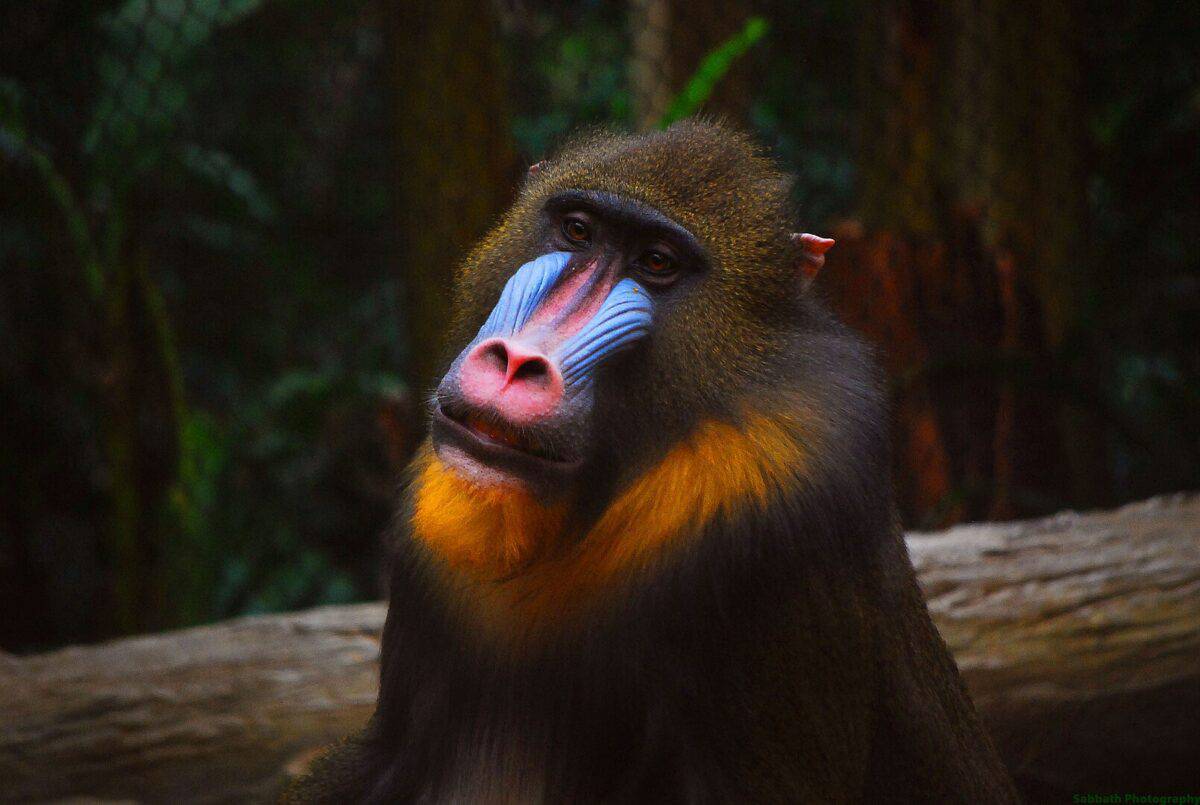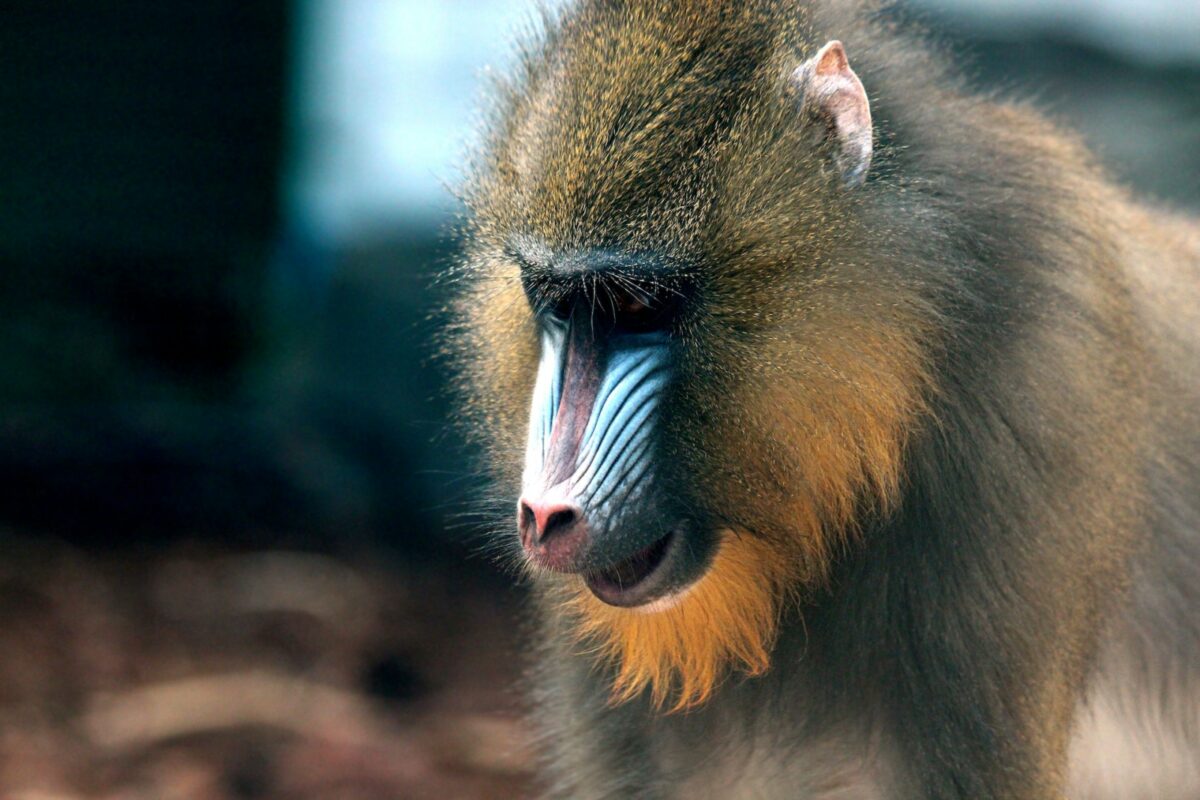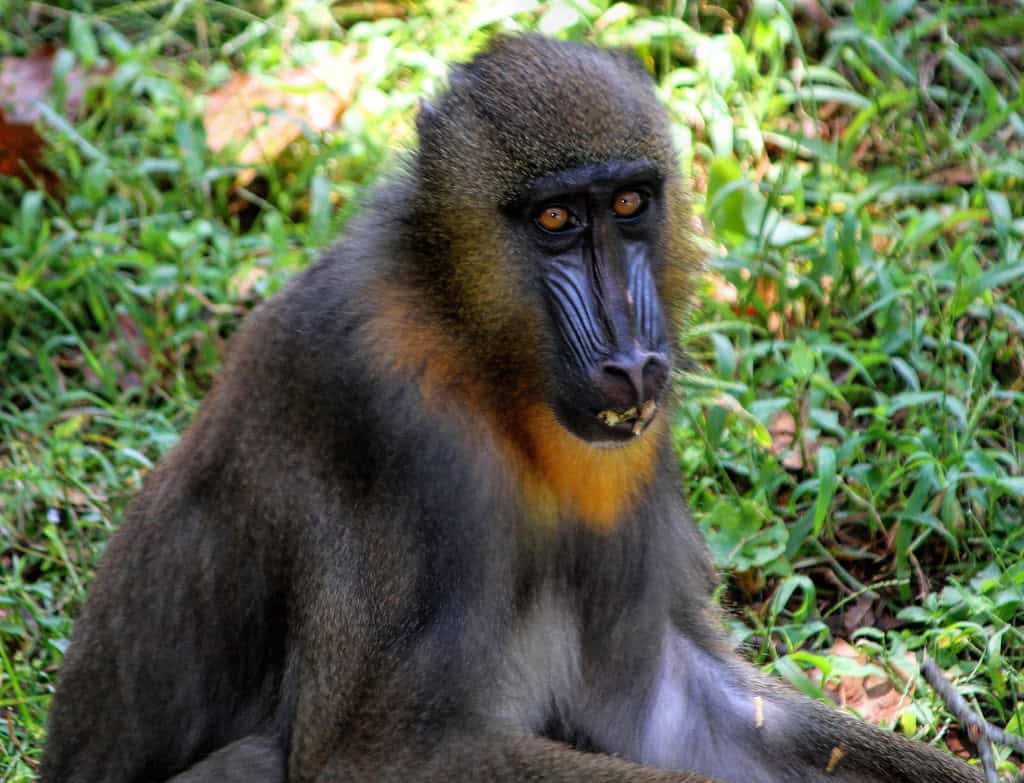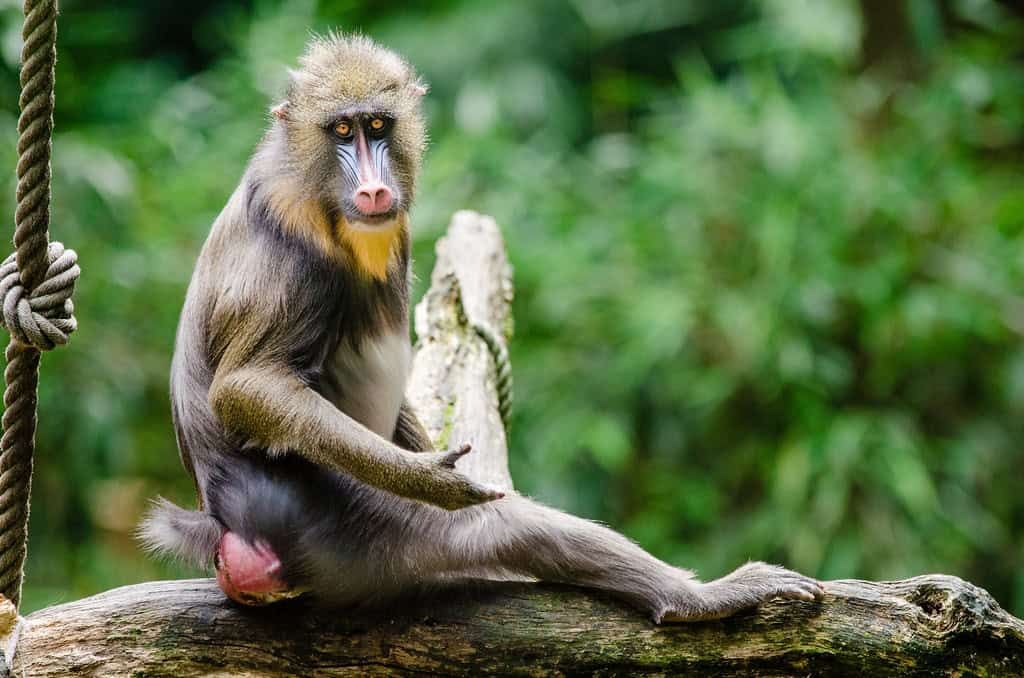Deep within the rainforests of Central Africa, one of nature’s most colorful primates engages in a sophisticated communication system that rivals human social media for its visual impact. Mandrills (Mandrillus sphinx), often mistakenly referred to as baboons, are the world’s largest monkeys and perhaps the most visually striking primates on Earth. Their distinctive faces – painted in brilliant blues and reds – aren’t merely a random genetic flourish but function as an intricate communication system that conveys status, health, and reproductive readiness to other members of their community.
Unlike human communication that relies heavily on verbal language, mandrills have evolved a complex visual signaling system where color intensity, facial expressions, and body postures convey critical information within their social groups. These visual signals allow mandrills to maintain complex social hierarchies, coordinate group movements, and navigate potential conflicts without constant vocalizations that might attract predators. This remarkable adaptation represents one of the animal kingdom’s most sophisticated non-verbal communication systems, combining both permanent color signals and dynamic facial expressions.
The Science Behind Mandrill Coloration

The mandrill’s extraordinary facial coloration stems from specialized structures in their skin called chromophores. These microscopic collagen arrays reflect light in the blue spectrum, creating the striking blue ridges on their muzzles without requiring blue pigment. The vivid red hues, meanwhile, result from hemoglobin in blood vessels close to the skin’s surface. Unlike temporary blushing in humans, mandrills can maintain these colors through complex physiological mechanisms tied to their hormonal state. The coloration is not static but can intensify or diminish based on the animal’s physiological condition.
Research has revealed that these colors are honest signals – they cannot be faked because they’re directly tied to testosterone levels in males. Scientists have documented direct correlations between color intensity, testosterone concentration, and social rank. Males with the brightest red noses and most vivid blue facial ridges typically have the highest testosterone levels and hold dominant positions within their social hierarchy. This biological truth-in-advertising ensures other mandrills can accurately assess a potential rival’s strength or a potential mate’s fitness at a glance.
Facial Color as a Status Symbol

Among male mandrills, facial coloration serves as an unmistakable status symbol. The alpha male, who holds breeding privileges and social dominance, displays the most vibrant red nose and muzzle, accompanied by electric blue facial ridges that can be seen from considerable distances through the forest understory. This color intensity directly correlates with testosterone levels, creating a visible hierarchy that other mandrills can read instantly. When a male loses his dominant position, his colors actually fade as testosterone levels drop, providing a real-time visual update of his changed status.
This color-coding system helps prevent unnecessary violent confrontations. Subordinate males with less vivid coloration can quickly assess that challenging a brightly colored dominant male would be futile, allowing the group to maintain relative harmony without constant physical contests for dominance. Scientists studying wild mandrill groups have documented that aggressive encounters between males decrease when color differences are more pronounced, suggesting that this visual signaling system evolved partly to minimize costly physical conflicts while maintaining clear social boundaries.
Female Coloration and Reproductive Signaling

While less dramatic than males, female mandrills also use color to communicate, particularly regarding their reproductive status. During estrus (the fertile period), females develop subtle but noticeable pink swellings and color changes around their genital and perineal areas. These color shifts signal sexual receptivity to males while also indicating optimal fertility timing. Some research suggests that females with more pronounced color changes may attract more attention from dominant males, potentially increasing their chances of mating with high-status partners.
Beyond reproductive signaling, female mandrills display subtle facial coloration that changes with age, health status, and social rank. Higher-ranking females typically show slightly more pronounced facial coloration than lower-ranking individuals. This visual hierarchy helps maintain order within the female social network, which forms the stable core of mandrill societies. The subtle nature of female coloration compared to the dramatic male displays reflects the different social pressures and reproductive strategies at work between the sexes in mandrill communities.
The Role of Facial Expressions in Communication

Beyond their permanent coloration, mandrills possess an impressive repertoire of facial expressions that add dynamic elements to their communication system. Their highly mobile faces can produce over 20 distinct expressions, each conveying specific information about emotional states and intentions. The “threat gape” display reveals their impressive canine teeth while narrowed eyes and flattened ears signal aggression. Conversely, the “submission grimace” involves pulling back the corners of the mouth without showing teeth, effectively communicating non-threatening intentions to more dominant individuals.
Mandrills can rapidly shift between these expressions, sometimes combining them with body postures to create nuanced messages. For example, a submissive grimace paired with an averted gaze and hunched posture clearly communicates deference to a higher-ranking individual. Young mandrills learn these expressions through observation and social interaction, gradually mastering the subtle differences between various displays. This facial expression system works in concert with their color signals, allowing mandrills to communicate both long-term status (through color) and immediate intentions or emotional states (through expressions).
Body Postures and Movement as Communication

Complementing their facial signals, mandrills use a sophisticated system of body postures and movements to convey information. Dominant males often adopt a distinctive swagger when moving through their territory, walking with an exaggerated gait that emphasizes their size and strength. This postural communication reinforces the status already signaled by their facial coloration. In contrast, subordinate mandrills move with a more hunched posture, often giving way physically when dominant individuals approach, keeping their heads lower and movements more restrained.
During aggressive encounters, mandrills display ritualized body language that helps prevent conflicts from escalating to dangerous levels. A dominant male might present his brightly colored rump or perform a “head bob” display before physical aggression occurs, giving subordinate individuals an opportunity to retreat or submit. Females also use subtle body language, including presenting behaviors during estrus that combine with their color signals to communicate reproductive readiness. These movement patterns and postures work together with facial signals to create a comprehensive visual communication system.
Vocal Communication Complementing Visual Signals

While visual signals form the foundation of mandrill communication, they don’t tell the complete story. Mandrills also utilize a diverse vocal repertoire consisting of approximately 30 distinct calls that work in conjunction with their visual displays. Low-frequency “two-phase grunts” often accompany submissive facial expressions, reinforcing peaceful intentions. In contrast, high-pitched “yaks” and aggressive roars typically coincide with threat displays and intense facial coloration during confrontations between males.
Researchers have noted that vocal communication becomes particularly important in dense forest environments where visual signals might be obscured by vegetation. Mother mandrills develop specific contact calls with their infants, allowing them to maintain connection when separated in the forest. The integration of vocal and visual communication creates a multimodal system that functions effectively across different environmental conditions. This adaptive flexibility helps explain how mandrills can maintain complex social structures despite living in challenging rainforest habitats where visibility can be limited.
Color Changes During Development

The development of mandrill coloration follows a fascinating trajectory that reflects their social maturation. Infant mandrills of both sexes are born with pale faces and minimal coloration, making them less visually distinctive within the group. As young males approach sexual maturity around 6-7 years of age, they begin developing their characteristic facial coloration, though initially at low intensity. This gradual development of color signals allows young males to integrate into the adult social hierarchy without immediately challenging established dominant males, potentially reducing conflict.
The full expression of male coloration typically coincides with achieving social dominance, creating a visual transformation that can be dramatic. Researchers tracking individual males have documented cases where coloration intensified within weeks following a rise in social status. This developmental pattern illustrates how tightly mandrill coloration is linked to both physiological and social factors. Young females also develop subtle increases in facial coloration as they mature, though never reaching the dramatic intensity seen in adult males, reflecting their different social roles within mandrill communities.
How Mandrills Perceive Color Signals

Mandrills possess excellent color vision, an adaptation that allows them to accurately perceive and interpret the subtle variations in facial coloration of their group members. Unlike many mammals that have limited color perception, mandrills have trichromatic vision similar to humans, enabling them to distinguish fine variations in reds and blues that form the basis of their visual communication system. This visual acuity allows mandrills to detect even small changes in color intensity that might signal shifts in social status or health condition.
Interestingly, research suggests that mandrills may be particularly sensitive to the specific wavelengths of light reflected by their facial coloration. Their visual system appears evolutionarily tuned to detect the exact shades of red and blue that appear on conspecifics’ faces. This specialized perception ability ensures that even subtle variations in coloration – which might indicate important differences in testosterone levels or health status – can be accurately assessed by other group members. This co-evolution of signal production and signal perception represents a sophisticated adaptation that enhances the reliability of their visual communication system.
The Social Context of Color Communication

Mandrill color signals don’t exist in isolation but function within a complex social context. These primates typically live in large multi-male, multi-female groups called hordes that can contain hundreds of individuals in the wild. Within these groups, color communication helps establish and maintain a dominance hierarchy that determines access to resources and mating opportunities. The visual nature of these signals means that many individuals can simultaneously receive the same information about an individual’s status, creating efficient group-wide communication.
The effectiveness of color signaling varies depending on social circumstances. During stable periods, color differences help maintain established hierarchies with minimal conflict. However, during times of social upheaval – such as when a dominant male is weakening or when young males are challenging for status – color signals become particularly important as indicators of changing power dynamics. Researchers have observed that males actively beginning to challenge for dominance may show increasing color intensity even before they’ve won significant confrontations, suggesting that the physiological changes underlying dominance transitions precede the actual social reorganization.
Environmental Influences on Color Communication

The effectiveness of mandrill color signals is influenced by their natural environment. The rainforest habitat where mandrills evolved is characterized by dappled light conditions, with bright patches of sunlight filtering through the canopy interspersed with deep shadow. The vibrant blues and reds of mandrill faces are particularly visible in these lighting conditions, standing out against the predominantly green background of the forest. Some researchers suggest that mandrill coloration evolved specifically to maximize visibility in this challenging visual environment.
Seasonal variations in the forest environment may also affect color communication. During drier seasons when foliage is less dense, visual signals can travel further and be seen more clearly. Conversely, during heavy rainy seasons with thicker vegetation, mandrills may rely more heavily on vocal communication to supplement visual signals. The group’s movement patterns through different forest types – from dense understory to more open canopy areas – also affects how effectively color signals can function. This environmental context helps explain why mandrills have evolved such extraordinarily bright coloration compared to other primates in different habitats.
Conservation Implications of Understanding Mandrill Communication

Understanding the sophisticated communication system of mandrills has important implications for their conservation. Mandrills are classified as vulnerable on the IUCN Red List, with populations declining due to habitat loss and hunting pressure. Their complex social structures, which depend heavily on visual communication, may be disrupted when groups are fragmented by human activities or when key individuals are removed through hunting. Conservation efforts that preserve intact social groups and their natural communication patterns are likely to be more successful than approaches that ignore these social dynamics.
Research into mandrill communication also provides valuable insights for captive management and breeding programs. Zoos and wildlife centers can use knowledge about the importance of visual signaling to create appropriate social groupings and environmental conditions that allow natural communication patterns to develop. For example, providing adequate space and social complexity for males to establish normal dominance hierarchies – complete with accompanying color development – may improve welfare and reproductive success in captive populations. This scientific understanding thus bridges the gap between fundamental research and practical conservation applications.
The Remarkable World of Mandrill Communication

The communication system of mandrills stands as one of nature’s most remarkable examples of visual signaling, combining permanent biological features with dynamic expressions to create a sophisticated language without words. Their vivid facial coloration – functioning as an honest signal of status and health – works alongside an extensive repertoire of facial expressions and body language to maintain complex social structures in their challenging rainforest environment. This multi-layered communication system allows mandrills to navigate social relationships, reduce costly conflicts, and coordinate group activities with remarkable efficiency.
As we continue to study these extraordinary primates, we gain not only a deeper appreciation for their unique adaptations but also broader insights into the evolution of communication systems across species. The mandrill’s colorful face reminds us that nature has developed countless innovative solutions to the universal challenge of social communication. In their vibrant displays and nuanced expressions, we find a window into the complex social lives of our primate relatives and perhaps even glimpses of the evolutionary foundations of our own human communication systems.
- Do Animals Dream? What Research Reveals - August 18, 2025
- The Golden Eagle of Utah – A Majestic Hunter of the High Desert - August 18, 2025
- The Mammal That Can Survive the Longest Underwater Without Air - August 18, 2025

